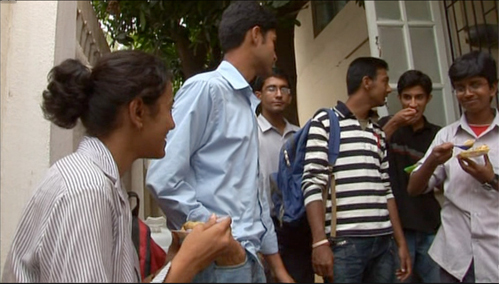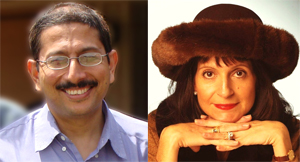
Bob Compton's film, Two Million Minutes, explored how Indian students spend their time
The goal is education. We have 64 million students in it. India has about 320 million (ages 5 to 14). Bob Compton's film, Two Million Minutes, observed that many students in India and China spend more time acquiring academic knowledge. What works in the Indian culture is going to be different from what works in our American culture. Some might argue we spend our time developing the well-rounded child . Does it matter to many Americans that while we study the Super Bowl and Glee, Indian and Chinese students spend more time building their intellectual foundation? Yes, poverty and weak infrastructure are challenges India faces, but often when you're coming from behind you're more hungry to achieve. These are our global friends and our competitors.
It is India Time -- India will participate in the next PISA test (Program for International Student Assessment) -- for the first time. There have been a number of new educational initiatives that have made this possible. One of the major programs was explained to me by Sridhar Rajagopalan (Head of Educational Initiatives), a man on a mission to revolutionize the way Indians and others think about learning.
What kind of educational system will permit India to have the people skills needed to compete globally?
The goal would be to have an educational system that allows people to reach their full academic potential. This will enable India to compete globally and to have a domestic society where people are engaging meaningfully and are able to solve the problems faced by their society. The system would need to focus on academic excellence and research, and also on developing compassionate and caring individuals.
What are your major challenges?
One of the basic problems the Indian education system faces is our high focus on rote learning. The problem of rote learning is discussed in many countries around the world, including America. However, I think rote learning is a severe problem in India. Rote learning is like saying you don't need to understand; you don't need to be able to think and apply knowledge; as long as you can recite what is in a lesson in a textbook, that's fine. This problem is reflected in our school leaving exams. It's reflected in the fact that certification is the all important focus, versus learning. The problem is even more serious in rural areas where children are struggling to develop basic skills. So our system needs to focus on learning with understanding, developing critical thinking skills, and developing a lifelong passion for learning.
So if you change the way you test, it might influence the way children are taught?
Absolutely. The primary purpose for which we use testing is so that the system, the parents, the teachers, and the government understand that students are learning. If we change the way we currently test, we can improve both the way we teach and the quality of what children learn. We are beginning to make the first few steps in this direction.
What have you done in the past 5 - 10 years to improve student assessment?
We began our work with low stakes assessment. The first step involves regular assessments. The purpose is to diagnose and to give a benchmark. Our diagnostic work has been considered cutting edge compared to the rest of the world. One of our advantages is our very large sample base of students. The second advantage we have is that we go into great depth in our diagnostic work, e.g. what do students understand about angles. When we do a student assessment we capture the students' responses on video. The videos become very helpful in training and supporting the teacher.
The next step is where the technology comes in. In each stage of teaching a new concept, there are many potential misconceptions by students. Instead of expecting a teacher to identify all these misconceptions when she has 35 or more children in her classroom, we have discovered that with carefully developed computer programs, we can do that for the teacher. Let me give you an example. If a child has not grasped a concept, a teacher might feel she needs to teach that child the concept all over again. With the help of our diagnostic tools, we can assist the teacher to better understand exactly where the child's lack of comprehension lies, enabling the teacher to better focus the child towards the correct answer. We have created a personalized, intelligent computer based learning program that is based on the misconceptions research -- a program called Mindspark that has been used by leading Indian schools for over 2 years, and has just started to be used in rural India and the US.

An Indian Classroom (photo courtesy of Teach for India)
How broad is the distribution of this assessment initiative and what has been its impact?
We currently work with 3,000 private schools. Similarly we are working in government schools in about 20 out of 28 states in India, many countries of South Asia, the Gulf, and in Singapore. Through an initiative supported by Google and in partnership with various state governments, we conducted a detailed class-wise assessment on student learning levels in 2009. We have just completed an assessment (in partnership with the government of Mumbai, UNICEF and McKinsey) for every single child in Mumbai in 3rd and 6th grade, and are now doing the same thing with two of our other most progressive states. We expect to see additional states following this lead. Governments have invited us to join committees to reform assessments based on our success. Large systems tend to move slowly, but people are interested in making the kinds of changes I am describing. The fact that government has now supported India's participation in PISA is an example of government confidence that this approach is working.
What is your view about the impact of academic pressure on student mental health and emotional well being?
Our problems right now in India are different to those of more developed nations. India has a poor education system. However, our society values education more than anything. Success in education means getting a good job. Right now, a very small percentage (less than 15%) of our children reach higher education. This is not because of lack of interest. Our problem is poverty and low quality of education. In certain elite schools, there has been some discussion about pressure and test taking. But most parents and teachers believe the pressure is inevitable and necessary because of the competition that exists due to supply and demand for good college places.
What is your vision of the well educated Indian student?
There would be three constants. The first bucket I would call critical thinking, which would include creative thinking and the ability to solve problems. Values and ethics would be in my next bucket: compassion and sensitivity and an understanding of the importance of contributing to your society. Then my final bucket would include strong academic stills along with the desire to excel and to do excellent work.
World Wisdom from India
Rote learning will not lead to educational excellence. A successful system will not focus on end of school exams, but rather on the ability to think and apply knowledge and to produce compassionate and sensitive human beings. Change the way you test to improve the way you teach and the quality of learning. The value that society places on education and the individual's hunger to learn will have a significant impact on a country's educational progress.

Sridhar Rajagopalan and C. M. Rubin
In The Global Search for Education, join C.M. Rubin and globally renowned thought leaders including Sir Michael Barber (UK), Dr. Leon Botstein (US), Dr. Linda Darling-Hammond (US), Dr. Madhav Chavan (India), Professor Michael Fullan (Canada), Professor Howard Gardner (US), Professor Yvonne Hellman (The Netherlands), Professor Kristin Helstad (Norway), Professor Rose Hipkins (New Zealand), Professor Cornelia Hoogland (Canada), Mme. Chantal Kaufmann (Belgium), Professor Dominique Lafontaine (Belgium), Professor Hugh Lauder (UK), Professor Ben Levin (Canada), Professor Barry McGaw (Australia), Sridhar Rajagopalan (India), Sir Ken Robinson (UK), Professor Pasi Sahlberg (Finland), Andreas Schleicher (PISA, OECD), Dr. David Shaffer (US), Chancellor Stephen Spahn (US), Yves Theze (Lycee Francais US), Professor Charles Ungerleider (Canada), Professor Tony Wagner (US), Professor Dylan Wiliam (UK), Professor Theo Wubbels (The Netherlands), Professor Michael Young (UK), and Professor Minxuan Zhang (China) as they explore the big picture education questions that all nations face today.
